1974 U.S. Postal Service Christmas Stamp
A couple glides through an endless snowscape, with no sound but jingling sleigh bells, the rhythm punctuated now and then by a horse's whinny or snort. It's like a scene from a romantic movie - and yet, the Currier and Ives lithograph shown below once would have fit Hicksville very well.
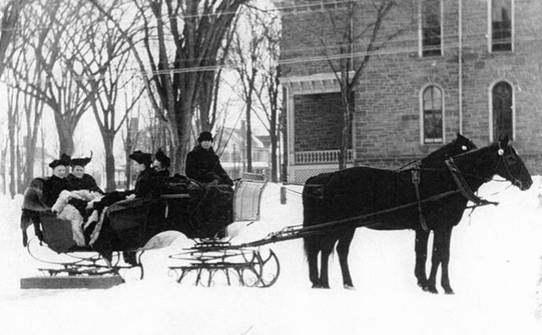
New York State Archives Digital Collections
***
During many winters around 1900, people on Long Island both enjoyed and depended on sleighs. Back when horses provided the horsepower, roads went unplowed. You would hitch the same horse(s) to your wagon in July and to your sleigh in January - like having a convertible for the summer, and an SUV for the winter, but having only one engine that they shared. As long as the snow was going to stay around a while, and you didn't have to switch back and forth every few days, the arrangement worked out well. You could even go one step further: also take the wheels and axles off your warm-weather carriage, and replace them with runners, as in the above picture.
Long Island can be a magnet for deep snowfalls (e.g., in the winter of 1960-1961, it got three falls deeper than 12"), but the snow that "sticks" to the ground in Hicksville rarely stays snow-like for long. It usually evaporates a little more each day, or it melts and refreezes, steadily devolving into lumpy, hard grey ice - and you can't very well ride a sleigh over that.
From the 1880s through the 1920s, however, Long Island's weather often followed a different pattern. Many of those years' frigid winters brought abundant and enduring snow, ideal for sleighing, and people took advantage of it. The Brooklyn Standard Union reported that during the winter of 1904-1905, a local man had been able to drive his sleigh through the snow on a total of 72 mornings. Wow.
This photograph was taken in Bellmore about 1880.

New York State Archives Digital Collections
Obviously, small sleighs like the one shown above were good for personal transportation, such as going to church, or visiting friends who lived across town. Taxi drivers also might use them, say, to pick up fares at the railroad station. Alternatively, larger sleighs could be hired to transport groups of people.
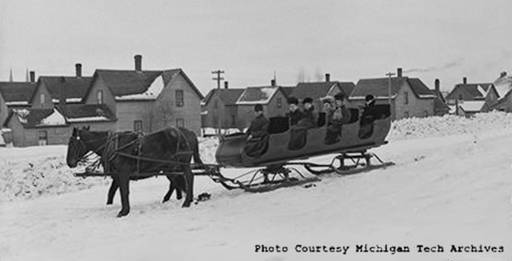
***
For those who bundled up well, sleighriding in cold fresh air was considered both healthy and fun. Community organizations sponsored free sleigh rides for children. Not surprisingly, the faculty of the Union Free School (i.e., the school on Nicholai Street) chartered sleighs to tour various parts of Long Island, enjoying the sight of the snow cover on the landscape, and no doubt learning things about the towns they visited. A group of Hicksville "sportsmen" ventured by sleigh into Suffolk County to participate in a "hog guessing" contest. There also was the forerunner of today's large motorcycle rallies: in the 1890s, more than 220 sleighs participated in a massive round-trip ride between Oyster Bay and Huntington.
An eveningsleigh ridefor two was a favorite form of dating (or double-dating, if the sleigh had two bench seats). You could just ride "to nowhere," or maybe you would go out for dinner to a favorite romantic spot in another town, as when the people in this news article came to Hicksville in 1893.

Sometimes, proprietors encouraged winter sleigh travel by offering special incentives to attract people who did not reside in Hicksville, as in this case:


All three items above are from the HuntingtonLong-Islander
***
A recurring problem during the "big snow" years was the stranding of Long Island Railroad trains, often because of immense snow drifts - 12 feet or more high - east of Hicksville. Scores of people would be marooned on the trains, which somehow never managed to get stuck close to a town. When news of their plight reached Hicksville, a flotilla of sleighs would head east to rescue the passengers, bringing them back for warmth, food, and overnight lodgings in the several hotels near the railroad station.
The following reports date from 1896 and 1902, respectively.


Both items above are from The Brooklyn Daily Eagle
When severe snowstorms surprised the East Coast in the 1890s, the Long Island was as well-equipped as other major railroads to clean up after them. This photograph from 1898 shows the crew of a plow train taking a break. I recall that this snow plow - or one of its identical siblings (the LIRR acquired a few of these units c.1896) - survived at least until the 1950s. For many years it stood waiting for work at Hicksville, a short distance west of the station, sitting on a siding to the north of the main tracks.
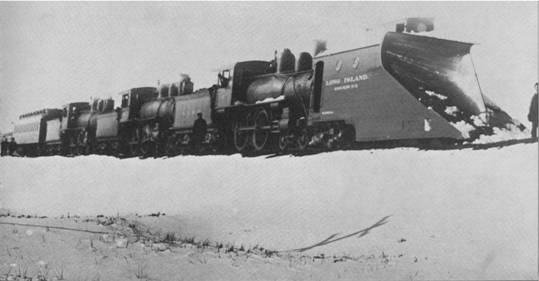
Photograph by H.B. Fullerton, Collection of St. James General Store, as printed in Steel Rails To The Sunrise
***
Travelers were not the only people who needed sleighs when deep snows fell. This news item is from 1920.

Hicksville's Fire Department had started acquiring powered fire trucks in the 1910s, but with rural snow-plowing not yet commonplace, the new trucks were no match for exceptionally big snowfalls. And so, when an alarm was sounded after one February 1920 storm, there was no alternative but to use a sleigh to get to the fire - but the Department had no horses at the ready. What to do? No problem; a civic-minded delivery service volunteered theirs:

Both items above are from the Huntington Long-Islander
As can be inferred from the above news item, when snows made roads impassable to wagons, retailers and express companies delivered goods via sleigh. According to the 1897 Sears Roebuck and Co. Catalogue, farmers and businesses could order runners and other sleigh hardware, so that they could make their own vehicles similar to the one shown here, with capacities ranging from 3,000 to 8,000 pounds.
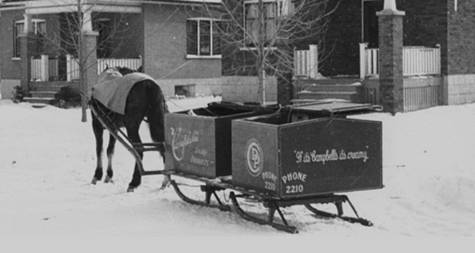
Trent Valley (Ontario) Archives
Things usually worked out well, but in early 1926 an express driver's day went awry as he made a delivery on Hicksville's Broadway:

Above item from the HuntingtonLong-Islander
***
Mischievous little boys were not at all necessary for things to go wrong: sleighing had inherent risks, and carelessness proved fatal more than once.
A sleigh full of people was top-heavy; on a tight curve, it might roll over, and come crashing down upon its occupants. Even when going straight ahead, what looked like a smooth white route might conceal a rock or fallen branch, sturdy enough to make the runners on one side of a speeding sleigh bounce upward, and send people hurtling over the side. Sleighs sometimes had problems crossing the LIRR tracks, and would spill their passengers on the ground. Even if everything else went well, horses could get startled by anything - a child on a toboggan coming downhill towards the road ahead, or the sound of an automobile horn - and then start galloping willy-nilly, tipping over their sleighs before they broke free. And, of course, a sleigh might be struck by another vehicle.
During the winters of the glorious snowfalls, the columns of The Brooklyn Daily Eagle and the Long-Islander often mentioned sleighing casualties.
- One night, a Hicksville woman was thrown from her sleigh. She landed in soft snow, but the horse and sleigh continued on out of sight. She became disoriented. By the time she was found, frostbite and hypothermia were setting-in.
- A member of the Hicksville Athletic Club needed weeks to recover after being thrown from his sleigh and "dislocating both ankles."
- Another man separated his shoulder when he lost control of his sleigh as it crossed the LIRR tracks in Hicksville.
- A Hicksville doctor, out on a call, also lost control of his sleigh while crossing the railroad tracks, injuring both his horse and himself in the crash. Afterwards,he hired a chauffer. One day, while the chauffer was out in the snow exercising the horse, the sleigh overturned, and he injured his knee badly.
- As two Hicksville couples traveled to Jericho, their sleigh was hit by a car, which had been "borrowed without permission" by a youth who was trying to impress some young ladies. Their injuries were minor, but the sleigh was a write-off, and the driver of the automobile was arrested.
- Between Farmingdale and Bethpage, a sleigh carrying a mother and her teenaged daughter overturned when its horse plunged into deep snow.The mother was thrown clear, but the inverted sleigh landed atop the daughter, pushing her deep into the snow.With the help of a nearby farmer, the sleigh was righted - but by then the poor girl had been asphyxiated.
In hindsight, today's reader might think that sleigh-riders should have worn seatbelts, or at least used sleighs with higher sides (or even roll bars), but such thinking was not part of Victorian/Edwardian culture. Whether people chose to use sleighs, or they had to use them, they simply accepted them as they were.
***
Notwithstanding the risks and the potential carnage, sportsmen took great pride in racing their sleighs. Newspapers reported on who had just bought a new sleigh, or whose trotter or pacer was said to be the fastest horse in town. Races, both spontaneous and pre-arranged, attracted admiring spectators. Venues included both quiet rural roads and main village streets. The photo below shows a 1910 sleigh race in the heart of East Hampton.
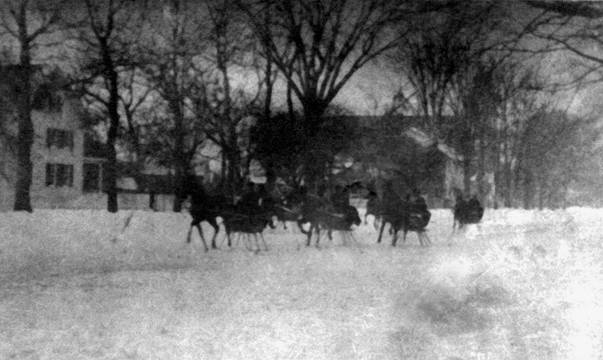
NewYorkState Archives Digital Collections
Spontaneous races "for fun" could arise between any vehicles on runners, regardless of their respective sizes and the animals that pulled them. One newspaper article mentioned a race between a work sleigh, pulled by a large draft-horse (think Budweiser), and a lightweight sleigh, pulled by a spirited carriage horse.
For those who raced seriously, the standard vehicle of choice was a two-seat, single-horse open sleigh, of a type called a cutter. I have yet to find a clear definition of what qualified a sleigh as a cutter, other than perhaps its not being very heavy for its size. To further confuse the issue, I also have seen references to a type of sleigh known as a speeder, built just for racing, pictures of which so strongly resemble a cutter that I cannot differentiate one from the other.

Des Moines Buggy Company "AlbanyCutter" - from HansenWheels.com
Whatever the classification(s) of the sleighs, in organized races, the participating horses were either trotters or pacers. These two gaits persist today in harness racing, where they do not compete against each other.
While writing this article, I found myself imagining American Graffiti in the Snow - wise-cracking sleigh racers who cruised the main drags of their towns, in search of pick-up races against new competition.

Above item from the HuntingtonLong-Islander
(No, I have found no report of either Black Bean or his competitors overturning a sleigh so that it careened off the street and caught fire.)
When a race materialized, the people along Broadway in Hicksville (or Main Street in Huntington, or wherever) would clear the road and stop traffic, and then they would stand off to the side, ready to cheer on their favorite. Young boys, in effect early groupies, would try to tie pieces of ribbon of "their" respective colors to their favorite horses' harness, so that they might vicariously share in the glory of a victory.
The news item below announced the sale of a well-known local trotter, Pansy, to a Hicksville man. The seller was to use the money he received to purchase a car - but not until the snow was gone. Meanwhile, Pansy's new owner had all that he needed to race her, including a sleigh that would keep her in condition over the winter months.

Above item from the Huntington Long-Islander
***

americanmusicpreservation.com/jinglebellssong.htm
My Music Teacher at Lee Avenue Never Taught Us This Stuff
We've all sung Jingle Bells in our time, and we know what it's about, right? Well, perhaps not; let's review some things.
When the song was first published in the 1850s, it was called The One Horse Open Sleigh. Over the years, the original melody of the chorus has been dumbed-down a little; notes were adjusted to make it easier for people, especially children, to sing. You can hear the original melody at https://www.youtube.com/watch?v=YR6YAgVIljg
And about those bells... they jingle, but we really should call them "sleigh bells." Most likely, the phrase "Jingle bells" was intended to mean "Ring, sleigh bells!" with jingle being used as a verb - an idea which jibes with the lyric "Jingle all the way." Today, though, people may mistakenly interpret the phrase "jingle bells" as referring to a type of bell.
What is the song about? Obviously, it has nothing whatsoever to do with Christmas or Santa Claus. New Englander James Pierpont was the composer and lyricist (he also happened to be a nephew of J. P. Morgan). He wrote his sleighing song about the races he used to see in Medford, Massachusetts, where he was born. The song is about the joy and excitement of racing sleighs, about the young men who race them, and about their picking up girls.
The second verse - you can see the lyrics go by on the screen if you use the link provided above - mentions that the horse got into a snowdrift, upsetting the sleigh. We might expect that the couple in the sleigh had been ejected and injured. Since the song keeps going, however, we can assume that the driver and his Miss Fannie survived well enough.
The third verse refers to a race. The narrator has landed on his back in the snow. (Note that this sort of thing often occurred during races. If something startled a racing horse and it momentarily hesitated, the front of the cutter would suddenly dip downward, throwing the driver over the dash.) When the fallen driver looks up, he sees a rival sleigh pass by, the driver looking down at him and laughing at his misfortune. Apparently, sleigh racing was rather cut-throat. Who knew?
The fourth verse is racy, in more than one sense of the word. The listener is urged to get himself some girls while he is still young. All right, but how? Well, one way is to win races, by hitching his open sleigh to a horse that can do "2 40 as his speed." Huh? In the 1850s, 2 minutes and 40 seconds was considered an excellent time for a standardbred horse to trot a mile over smooth terrain.
Today, however, such a time would be quite poor. Thanks to an additional 160 years of breeding, better diet, better training methods, and improved sulkies, the record times for a one-mile distance on the various sizes of racing ovals are now in the 1:49 to 1:51 range.
No matter. In 2018, it seems almost impossible to meet a young woman who is attracted to men by the speed of their trotters, or by the quaint way in which their sleighs can throw a girl overboard into the snow. Ah, the Good Old Days.
Well, that's it for this month.
***
Whether or not you celebrate holidays at this time of year,
I wish you a wonderful December and a joyous 2019!
Sincerely,
Ron Wencer

